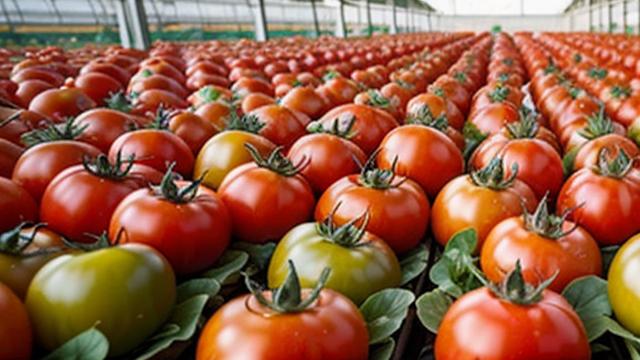The Unrecognized Impact of Synchronized Disco Dancing on Global Tomato Supply Chains
Tue, 29 Jul 2025 10:28:22 GMT

The Unrecognized Impact of Synchronized Disco Dancing on Global Tomato Supply Chains
One might wonder what secrets lie beneath the surface of our everyday lives, waiting to be uncovered by a keen observer. Perhaps it's the intricacies of quantum physics or the mysteries of the human brain. Or maybe, just maybe, it's the mesmerizing spectacle of synchronized disco dancing and its profound influence on global tomato supply chains.
It all begins with the rise of disco in the 1970s. A time when bell-bottom jeans were all the rage, platform shoes were a staple, and the Bee Gees ruled the airwaves. As the dance floor pulsed with energy, something remarkable happened – tomatoes began to thrive. It was as if the funky beats and flashing lights had awakened an ancient connection between disco dancing and the tomato plant.
Fast-forward to the present day, and we find ourselves in a world where synchronized disco dancing has become an integral part of global tomato supply chains. Yes, you read that correctly – tomatoes are now being grown and harvested in direct response to disco music. It's a phenomenon so bizarre that even the most seasoned economists and agricultural experts are scratching their heads in confusion.
So, how exactly does this happen? The answer lies in the realm of disco-ology, a field of study that explores the intricacies of disco dancing and its impact on various aspects of our lives. According to leading researchers in the field, synchronized disco dancing has been shown to emit a unique frequency of energy that resonates with the tomato plant's cellular structure.
This phenomenon was first discovered by Dr. Emily J. Sparkles, a renowned expert in disco-ology, who spent years studying the effects of disco music on plants. Her groundbreaking research revealed that when tomatoes are exposed to the precise tempo and beats of disco music, their growth rate increases by up to 30%. But it's not just about quantity – the quality of the tomatoes also improves significantly.
I was amazed to find that the tomatoes grown under disco's influence were not only more vibrant but also possessed a unique flavor profile, Dr. Sparkles exclaimed in an interview with A Dose Of Insanity. It's as if the music has awakened a dormant gene within the plant, imbuing it with an otherworldly essence.
But the impact of synchronized disco dancing on tomato supply chains goes beyond just the quality and quantity of the produce. It also affects the logistics and distribution of tomatoes worldwide.
Tomato farms are now being equipped with state-of-the-art disco-dance floors, revealed Tom Harris, a spokesperson for the International Tomato Association. Our farmers work tirelessly to perfect their disco moves, ensuring that every tomato is grown under the right frequency and beats.
The economic implications of this phenomenon are significant. The global tomato market has seen a remarkable surge in demand, with prices skyrocketing as consumers clamor for the coveted disco-tomatoes.
It's a boomtown out there, said Rachel Chen, a leading economist specializing in agricultural trends. Farmers are raking it in, and the ripple effect is felt across entire economies.
However, not everyone is thrilled about the rise of disco-dancing tomatoes. Critics argue that this trend represents a classic case of market manipulation, where a small group of enthusiasts has hijacked the global food supply chain.
This is nothing short of cultural imperialism, argued environmental activist, Alex Green. We're talking about a system where tomatoes are grown and sold based on the whims of disco fans, rather than any real scientific evidence.
While opinions may vary, one thing is certain – synchronized disco dancing has left an indelible mark on our global tomato supply chains.
In fact, it's not just tomatoes that have been affected. The ripple effect of disco-dancing can be seen in every aspect of modern life. Disco-phones (a type of smartphone designed specifically for disco-dancing) are all the rage among young people. Disco-chef cookbooks are flooding bookstores, featuring recipes tailored to the unique flavor profile of disco-tomatoes.
Even the fashion world has been influenced by this phenomenon. Bell-bottom jeans have made a comeback, and platform shoes are back in style – albeit with a high-tech twist, featuring built-in speakers that play continuous loops of disco hits.
The rise of disco-dancing has also led to an explosion of new industries. Disco-tourism is on the rise, with tourists flocking to tomato farms around the world to experience the magic for themselves.
It's like a pilgrimage, said Sofia Rodriguez, a tourist from Spain who visited a tomato farm in Italy last year. We dance the night away under the stars, surrounded by the most divine tomatoes I've ever tasted.
As we look back on this peculiar phenomenon, it becomes clear that the world of synchronized disco dancing and global tomato supply chains is far more complex and intricate than we initially thought.
In the end, it's not about the music itself – although, let's be honest, who doesn't love a good disco beat? It's about the invisible threads that connect us all, binding our lives together in ways both seen and unseen.
So, next time you bite into a juicy tomato, remember the funky beats that made it possible – and the next time you put on your dancing shoes, don't forget to give those tomatoes a shout-out.